|
:: ::
| I Viaggi Del Gusto UNDER THE TUSCAN SUN |
|
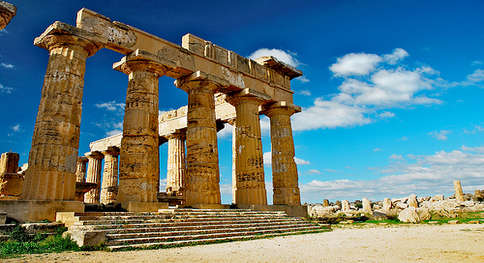 HIGHTLIGHTS OF SICILY HIGHTLIGHTS OF SICILY
- THE TEMPLES VALLEY OF AGRIGENTO
- TAORMINA AND THE GREEK FOOTSTEPS
- THE ETNA VOLCAN ALONG THE PHOENICIANS FOOTSTEOS
- THE AEOLIAN ISLANDS AND THE BEST FOODS
|
LIST PRIVATE GUIDED TOURS: SICILY AS YOU WANT
|
|
|
SICILY MERGER OF SECULAR CULTURES: VESTIGE OF ANCIENT CIVILIZATION INTRISE OF MEDITERRANEAN AROMAS
Do you like traveling because knowing the ancient city fascinates you?
Do you love stepping on the traces of prestigious past?
You are looking for evocative experiences that immerse you to become part of it
..FOLLOW WHAT YOU'RE TAKING UP AND WE GUIDE YOU IN THE EXPERIENCE THAT YOU WILL NOT COULD LIKE TO SEE !!!
|
CONTACT OUR
EMOTIONS' SAILOR 
|
SICILY TO VISIT
|
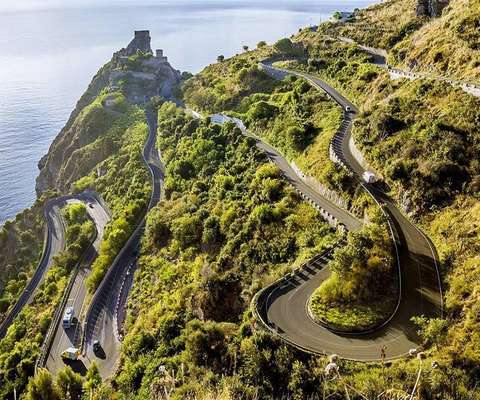
|
_________________
VISIT SICILY
_________________
AGRIGENTO
EXPERIENCES
TEMPLE VALLEY ETHERNAL BEAUTY [......]
_________________
ETNA
EXPERIENCES
EASTERN SICILY "BLACK LAND" OF THE ETNA VOLCANO [......]
_________________
SALTtowns
EXPERIENCES
TRAPANI: LANDS OF SALT, SUN AND.. PRAWNS AND MARSALA WINE [......]
_________________
EXPERIENCES
PALERMO
PALERMO CROCEVIA DI CULTURE ED AROMI [......]
_________________
MAGNAGREECE
EXPERIENCES
RAGUSA AND SIRACUSA: THE MAGIC GOLD OF MAGNA GREECE [......]
_________________
|
|
CITIES
PALERMO

Palermo, Sicily’s main port, nestles in the middle of a wide bay enclosed, to the north, by the Pellegrino Mount and, to the south, by Capo Zafferano. It lies on the edge of a very fertile plain that was called in the 15th century Conca D’Oro (meaning the golden shell or horn of plenty) on account of its lush citrus plantations, palm trees and olive-groves. At one time it was a favorite haunt of writers, poets and artists, who were enraptured by its eastern atmosphere and beauty.Built and grown over the course of centuries, Palermo conveys a range of diverse cultures and traditions. It suffered heavy damages during the Second World War bombings, its old quarters destroyed and never been completely rebuilt. Also, the construction of large modern crumbling buildings in the suburbs has done nothing to improve the city’s image. Nevertheless, it has preserved much of the priceless heritage handed down by the peoples who populated it. They left indelible traces not only in its artistic patrimony but in its very vital rhythm of life. Palermo becomes particularly lively in July during the Festival of the Patron Saint Rosalie, celebrated with a programme of events lasting five whole days. Palermo extends on a fertile plain called the Conca d’Oro (golden horn), along a bay comprised between the Pellegrino Mount and Capo Zafferano, the latter being a headland separating Palermo’s bay from Termini Imerese’s. Bathed by the Thyrrenian Sea, the coastline has plenty of lovely bathing spots that are crowded in summer months
AGRIGENTO AND THE TEMPLE VALLEY
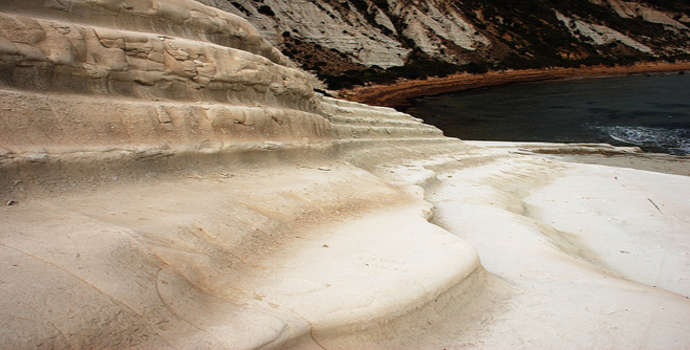
The province of Agrigento extends over a territory rich in natural resources and protected areas, such as the Montagnola – near San Giovanni Gemini, where is the renowned Acquafitusa cave, with impressing stalactites and stalagmites – the Cammarata Mount, Torre Salsa, and the Belice river’s mouth. The Pelagian archipelago also belongs to the province. The province of Agrigento is bordered by the Sicani Mountains to the north; the lower reach of the Salso river to the east and the Belice’s to the west; a tract of land comprised between the mouths of these two rivers, to the south. A plateau, rich in sulphur, stretches inland to the provinces of Caltanissetta and Enna. The coast, most featuring high dunes with finest sand, has various beautiful spots among which is the well-known Scala dei Turchi, an amazing chalky steep wall plunging down to the sea
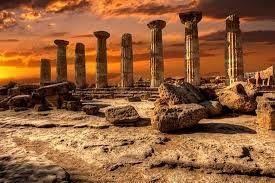
Stretched out along a ridge, inappropriately referred to as “valley”, and nestling in the area to the south of it, are a series of temples which were all erected in the course of a century (5C BC), as if to testify to the prosperity of the city at that time. Having been set ablaze by the Carthaginians in 406 BC, the buildings were restored by the Romans (1C BC) respecting their original Doric style. Their subsequent state of disrepair has been put down either to seismic activity or the destructive fury of the Christians backed by an edict of the Emperor of the Eastern Empire, Theodosius (4C). The only one to survive intact is the Temple of Concord which, in the 6C, was converted into a Christian church. During the Middle Ages, masonry was removed to help construct other buildings, in particular, the Temple of Zeus, known locally as the Giant’s Quarry, provided material for the church of San Nicola and the 18C part of the jetty at Porto Empedocle
CALTANISSETTA
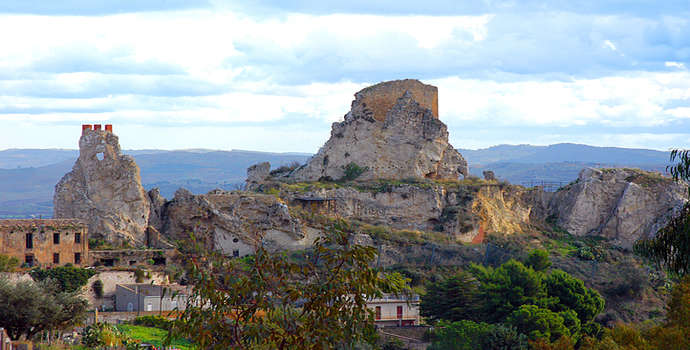
Caltanissetta is located on a hilly area in the upper valley of the Salso river, south of the San Giuliano Mount. The province has plenty of naturalistic sites such as the once larger Biviere lake, in Gela – today a favorite stop for migratory birds –, the lower valley of the Imera river – with archaeological and mining riches as well – the Soprano lake, the Sugherata wood in Niscemi and the valley of the Platani river. Since remote times the city of Gela with its renowned harbor has been an important outlet to the sea. The province can be divided into two large areas. The southern side, closer to the coast, comprises a number of considerably large cities, namely Gela, Niscemi, Riesi, Mazzarino and Sommartino; the northern, stretching inland, counts other fifteen cities.Located at the very heart of Sicily, Caltanissetta nestles atop a plateau at 568m asl. Founded by the Greeks, it underwent numerous dominations over the centuries. It achieved its greatest prosperity in the beginning of the 20th century thanks to the exploitation of the sulphur mines, that remained a leading industry until few decades ago when the fierce competition from American companies caused the closure of all its mines. Till then, the sulphur was exported worldwide, Caltanissetta’s output accounting for 80% of the world consume. Caltanissetta is particularly renowned for the celebrations of the Holy Week: on Good Thursday groups of 19th century statues by Neapolitan artists are arranged to represent scenes from the Mysteries of the Passion, the Deposition being particularly impressing; on Friday’s, the statue of a Black Christ is carried through the streets of the city. Throughout the year the statues are kept inside the Church of Pio X on Via Colajanni
CATANIA AND ETNA VOLCANO
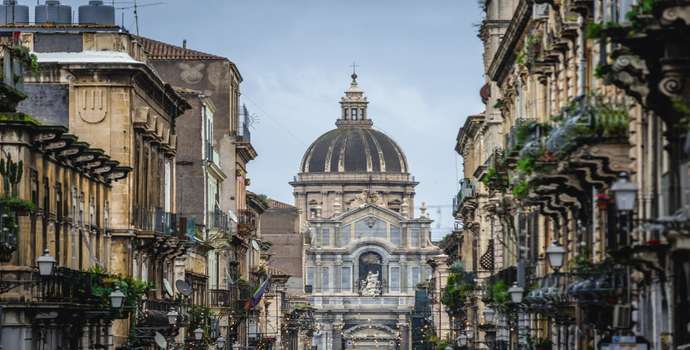
Catania lies in a very favorable location comprised between the Ionian Sea and the Etna, the European’s highest volcano that has heavily affected its history. Etna features four main lateral craters and several minor ones. The climate is hot, notably in the summer season. The coastline, stretching out to Riposto and referred to as the “Timpa”, is very distinctive, with a variety of amazing spots, high rocky walls – some reaching 100 metres in height – and caves, formed by marine erosion. Acqua Ranni – with a famous lava cleef –, Santa Maria la Scala, Santa Tecla, Stazzo and Pozzillo are among its most frequented sea resorts. The whole province is characterized by a rich flora, mainly the mediterranean bush.
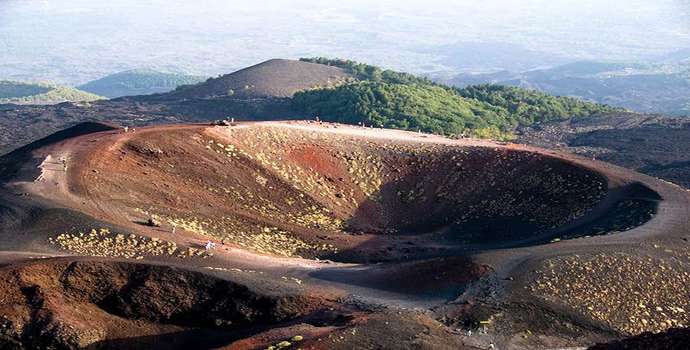
Catania is overshadowed by the Etna Mount, the volcano that often has betrayed the trust of the local people, sending forth great flows of lava, on one occasion down into the town itself. Reminders of its presence is the dark color of most monuments and buildings in town. Some of them is of plaster painted to look as lava. Black and white are the two dominating colors of the city that combine to produce a magnificent effect. The 17th century was particularly catastrophic for Catania. First (1669), following Etna’s eruption, a devastating lava river flowed into the city; few decades later (1693), an earthquake razed it to the ground. It followed a sumptuous reconstruction, the main protagonist being the architect Giovanni Battista Vaccarini (1702-1768) who designed the most prestigious buildings. The baroque covered nearly every ruined specimen of the past ages, that is hidden, with the exception of few remnants – below the new buildings and the city heart.
MESSINA
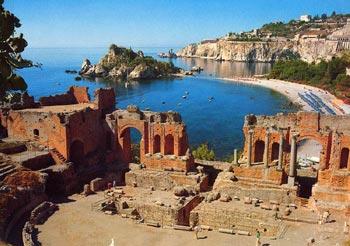
Messina is separated from the Italian mainland by a 5km tract of sea known as the Strait of Messina that was guarded, according to Virgil’s Aeneid, by Scylla and Charbydis. The worldwide known Aeolian Islands, with their uncontaminated environment, fall within the province’s administration, as well as other two important tourist sites, namely the Nebrodi mountain chain and the Alcantara gorge. The latter, arisen by eruptions of the Monio crater, forms part of a Nature Reserve comprising 14 cities between Catania and Messina provinces, home to a richest flora and fauna.5 kilometres separate Messina from the mainland Italy, what makes it the natural landing stage for people arriving from the peninsula. Hence the importance of its sickle-shaped harbour that in ancient times was given the name of Zancle. Messina history is therefore inextricably linked to the sea and to the straits that bear its name, and that, according to tradition, were guraded by two monsters, Scylla and Charybdis. The former was the daughter of Phorcys and Hecate. She is said to have twelve feet and six heads and to live under a cliff on the Calabrian side. It was she who flung herself at Ulysses’ ship, catching and decouring six of his sailors. On the Sicilian side of the strait, under another rock, lived Charybdis, who used to drink the sea water and regurgitate it three times every day (Odissey, Book XII, v 234-259)
ENNA
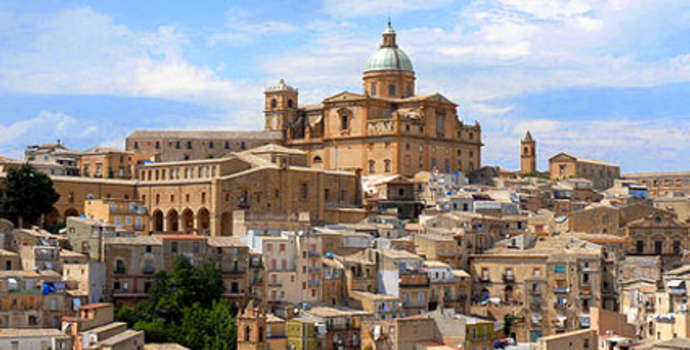
The city of Enna is set at the very heart of Sicily, perched atop a mountain, resembling an impregnable fortress. Standing at about 931 metres height, it has a cool climate even in the summer season. Its territory is endowed with natural resources such as the Rossomanno wooded area and the salt Pergusa lake, whose waters, according to mythology, witnessed the rape of Proserpine, daughter of Cerer, by Pluto. The Parco Minerario Floristella-Grottacalda, now a site of industrial archaeology, is located in the city vicinity; exloited up to few decades ago, the sulphur mines had been providing a major source of income and job.Occupying a magnificent position on a plateau 948m above sea level, Enna is known as the belvedere of Sicily; it is also the highest provincial capital in Italy. As the road winds gradually upwards to the town, beautiful views extend over the valley to Calascibetta, the town perched on the concave slopes of the hill opposite. The cult of Demeter – Ceres to the Romans – earth mother and goddess of fertility, was especially important here, possibly because of the extensive cultivation of wheat that continues to characterise this area. Furthermore, according to the Greek myths, it was on the shore of Lake Pergusa, that is not far from here, that Demeter’s daughter Persephone was abducted by Hades, the god of the Underworld; built at the highest point above Enna, in the place known as the belvedere, there used to be a temple dedicated to Demeter
RAGUSA
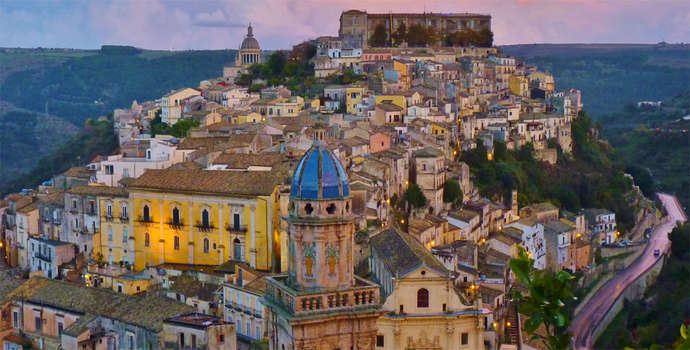
Bordered by the Channel of Sicily to the south and by the provinces of Caltanissetta, Catania and Siracusa from west to east, the province of Ragusa has a mainly mountainous territory which is almost entirely covered by the Iblean Mountains; this is why is often referred to as the Iblean area; the highest peak, the Lauro Mount, rises up to 986 meters. A flat area, being the main agricultural resource, stretches in the northern reaches of the province: it is the valley of the Ippari river, where the cities of Acate, Vittoria and Comiso have grown.The Iblean landscape is rather dry and rocky, the grounds being richest in limestone. Nonetheless, especially during the spring, it is able to offer the amazing colors of a wild and harsh beauty. The countryside is often crossed by gorges resulting from the rivers’ erosion throughout the centuries. The construction of dams on the Acate, Mazzarrone and Irminio rivers have resulted in precious reserves of water, in an effort to solve what has been a deep-rooted problem for the entire island. The province’s vegetation, varying according to the altitude, is largely Mediterranean. Oaks and plane-trees grow especially in the mountainside; while the oleander, the fig-tree, the acanthus, the caper, reeds and, most of all, the carob-tree can be found in the plain areas. The fauna, not very abundant because of the intense deforestation of the past centuries, is mainly comprised of wild rabbit, weasel and winged animals in the mountain side, rare birds like the pink flamingo, the soon-bill and the osprey in the marshy areas (notably near the dams), and several species of sea-gulls on the coast. The Mediterranean climate is characterized by cold winters and hot and dry summers in the mountainous and inland areas; while the coast is milder and more humid. Don't miss the Donnafugata Castle
SIRAGUSA
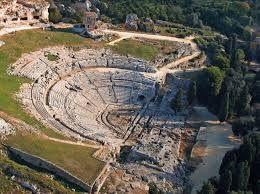
Syracuse has forever depended upon the sea, railying herself around the island of Ortygia, overlooking a wonderful bay on the east coast; its name is synonymous with an ancient Greek past, a series of valiant tyrants, the rivalry between Athens and Carthage; a past which has left a number of vestiges for the modern day visitor to see and enjoy. Alongside this dramatic historical background, there exists another less obvious past that can be explored among the streets of the island, where time seems to stand still somewhere between the medieval and Baroque eras. Just behind Ortygia stretches a flat area called Akradina – yet another name inherited from Antiquity. The district of Neapolis, literally meaning the ‘new town’, is one of the most evocative quarters claiming the theatre, the Ear of Dionysius and the Latomia del Paradiso within its boundaries. On the eastern side lies Tyche, so-called because there was a temple there dedicated to the goddess of fortune (from the Greek Tyche – fortune or luck). Dominating the remainder of the city is the part called Epipolae, guarded and defended by the Castle of Euryalus, strategically built in the most advantageous position
TRAPANI AND THE ISLANDS
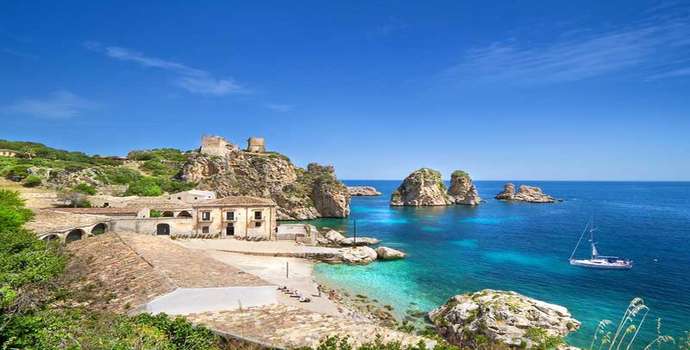
Trapani sits directly opposite the Egadi Islands providing them with regular comunication links with the main island. Beside the ferry traffic, the well-protected harbour handles large consignments of salt gathered in the saltpans just south of the town and tuna fish processed at the important local canning factory.Trapani, the ancient Drepanum, extends along a curving tongue of land that ends in two horns – one occupied by the Torre di Ligny, the other by a lazaretto (a house for the reception all the diseased poor, especially lepers). According to legend, this was formed by the sickle that was dropped by the goddess of agriculture Demeter (Ceres) while she desperately sought her daughter Persephone, who had been carried off by Hades. The inner edge of the sickle (north), sheltered by the Tramontana reef, provides protected anchorages and moorings for fishing-boats. Each morning, on the shore opposite is held a picturesque fish market (pescheria). The most exciting time to visit Trapani is undoubtedly over Easter when the old town is thronged with multitudes of people participating in the processions and festivities held during Holy Week. These celebrations culminate in the Processione dei Misteri on Good Friday as 20 groups of sculpted figures are borne round and through the streets all day and the following night. At other times, the statues are kept in the Church of the Purgatorio (in the town centre, in Via San Francesco); made of wood, cloth and glue by local craftsmen, they date from between 1650 and 1720.
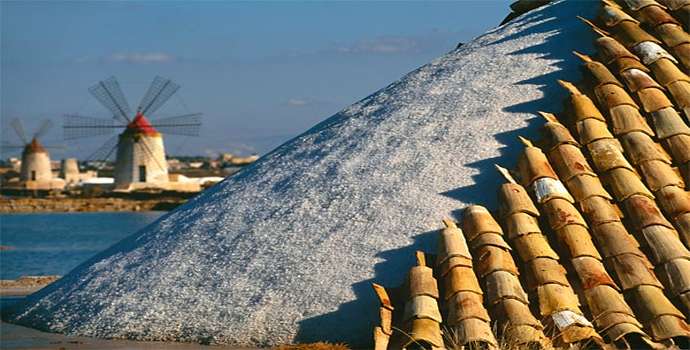
Tears of lava, limestone plains swept by the wind, sunny lands the colour of bronze: one by one the islands decorate the Sicilian coast like a string of pearls on the neck of a beautiful woman. There are fourteen of these daughters of Sicily, not including Motya, which at low tide is sometimes linked to the coast of Marsala. Fourteen paradises of untouched beauty. Some have an African charm, such as the Pelagie, in the province of Agrigento, and Pantelleria in the province of Trapani. Others, the uncontested mistresses of the sea and its secrets, Levanzo, Favignana, and Marettimo, form the archipelago of the Egadi in the sea off Trapani. Further north, in splendid isolation, is Ustica, the island of Circe, with its unspoilt marine reserve. And in the Aeolian islands, in the province of Messina, water meets fire. Here nature still dictates. Its rhythms, and travellers can let themselves be enchanted by the magic spell of the fishermen and farmers who inhabit these isles, the last custodians of the ancient Mediterranean traditions. The choice is yours - between the lively throngs on the Aeolian Islands, the peace and quiet Pelagie, and the perfumes of the Egadi
|